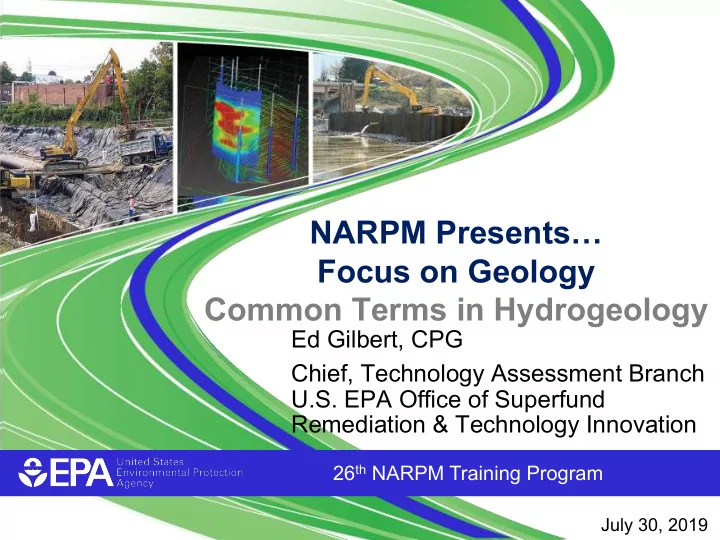

NARPM Presents… Focus on Geology Common Terms in Hydrogeology Ed Gilbert, CPG Chief, Technology Assessment Branch U.S. EPA Office of Superfund Remediation & Technology Innovation 26 th NARPM Training Program July 30, 2019
Basic Hydrogeologic Terms & Concepts • Aquifers, Aquitards, & Aquicludes • Porosity • Dual Porosity • Hydraulic Head & Hydraulic Gradient • Permeability & Hydraulic Conductivity • Isotropy & Anisotropy 26 th NARPM Training Program 1
Aquifers, Aquitards, & Aquicludes u Aquifer § A permeable geologic unit with the ability to store, transmit, and yield water in "usable quantities" u Aquitard A layer of low permeability that can store and transmit § groundwater from one aquifer to another u Aquiclude An impermeable confining layer. § § The USGS refers to both aquicludes and aquitards as “confining layers” or “confining units” 26 th NARPM Training Program 2
Aquifers, Aquitards, & Aquicludes VADOSE ZONE WATER TABLE UNCONFINED AQUIFER AQUITARD CONFINED AQUIFER AQUITARD CONFINED AQUIFER 26 th NARPM Training Program 3
Porosity u Ratio of volume of void space to total volume of medium u Where the fluids reside (Groundwater!) u NOT the same as Permeability § Clay has a very high porosity but a very low permeability u Particle size distribution and sorting § Well sorted (poorly graded) … uniform grain size § Poorly sorted (well graded) variety of grain sizes 26 th NARPM Training Program 4
Porosity VOID SPACE SOLID PARTICLE 26 th NARPM Training Program 5
Dual Porosity Systems u Systems in which there are high and low permeability units u Nearly all advective flow takes place through the pores in the high permeability materials (mobile porosity) u Water in the saturated pore spaces in the low permeability materials (immobile porosity) is dominated by diffusive, rather than advective flux u Pore water in the low permeability materials essentially serves as storage for solutes (dissolved contaminants) 26 th NARPM Training Program 6
Dual Porosity in Unconsolidated Media Immobile Porosity Relatively low permeability bypassed by advective flow and dominated by diffusive flux Mobile Porosity Relatively high permeability and dominated by advective flow Source: Chuck Newell and Tom Sale 26 th NARPM Training Program 7
Dual Porosity in Fractured Rock Small Fracture Porosity and Large Matrix Porosity 0.1 to 0.001% 2 to 25% DETAIL A mineral particle A Microscopic view of rock matrix 26 th NARPM Training Program 8
Hydraulic Head & Gradient ♦ Driving force (gw flow) ♦ Change in potential over distance ♦ Vector quantity (direction and magnitude) ♦ Three-dimensional 26 th NARPM Training Program 9
Hydraulic Gradient Variability with Depth at Pease AFB Site 32 Marine Silt & Clay – 40 ft Fill/Upper Sand – 50 ft Clayey Marine Silt – 44 ft Lower Sand – 35 ft Diamicton – 30 ft Source: Stone Environmental, Inc. 26 th NARPM Training Program 10
Permeability & Hydraulic Conductivity u Permeability (k) § The ease with which fluid will move through a porous medium § Property of the medium, such as clay, silt, sand or gravel u Hydraulic Conductivity (K) § The capacity of a porous medium to transmit water § Property of the medium and water u Note: § Multiple fluids may coexist in the same system, such as water and NAPL § Each fluid has a different conductivity within the same permeability regime § Conductivity is dependent on the density and viscosity of the fluid 26 th NARPM Training Program 11
Hydraulic Conductivity 26 th NARPM Training Program 12
Storage (>99%) Flow (>99%) 10 -6 cm / sec 10 -4 cm / sec 10 -2 cm / sec 26 th NARPM Training Program 13
Homogeneity and Isotropy u Homogeneous § Variable has same value regardless of position in space u Heterogeneous § Variable has a different value depending on its position in space u Isotropic § Variable has same value regardless of the direction in which it is measured u Anisotropic § Variable has a different value depending on the direction in which it is measured 26 th NARPM Training Program 14
Homogeneity - Heterogeneity Isotropy - Anisotropy 26 th NARPM Training Program 15
Isotropic vs. Anisotropic Isotropic Anisotropic 26 th NARPM Training Program 16
Complexity of Contaminated Groundwater Aquifers u Contaminated aquifers are highly diverse (even within similar environments and the same contaminants) u However, most contaminated aquifers share similar physical attributes based on the geological setting and the contaminants involved u These similar physical attributes provide for: § Generic discussion of physical and chemical transport processes § Standardized approaches to characterization and monitoring § Foundation for the Conceptual Site Model (CSM) u Site-specific characteristics provide the details of the CSM 26 th NARPM Training Program 17
Questions? • Aquifers, Aquitards, & Aquicludes • Porosity • Dual Porosity • Hydraulic Head & Hydraulic Gradient • Permeability & Hydraulic Conductivity 26 th NARPM Training Program 18
Recommend
More recommend